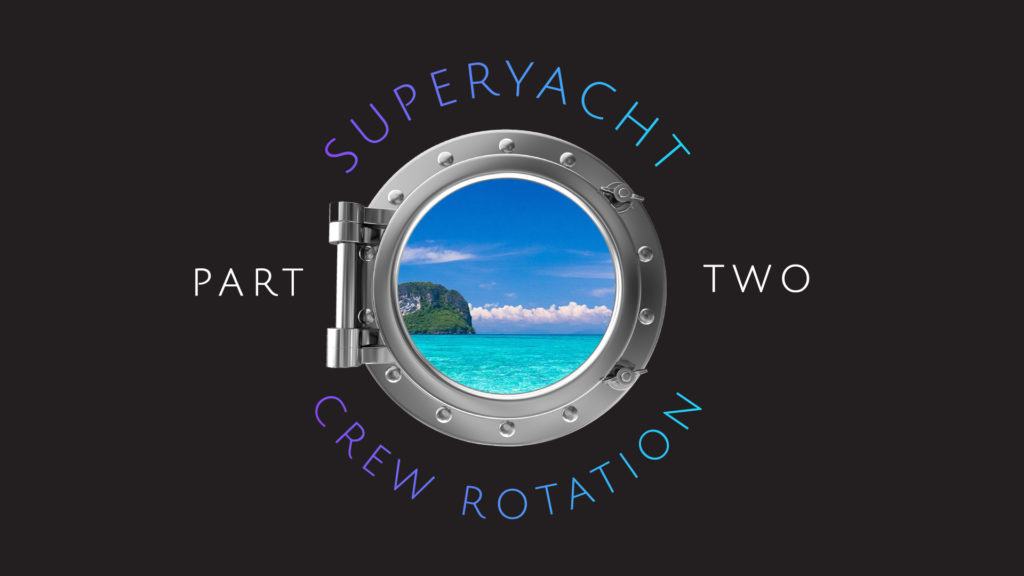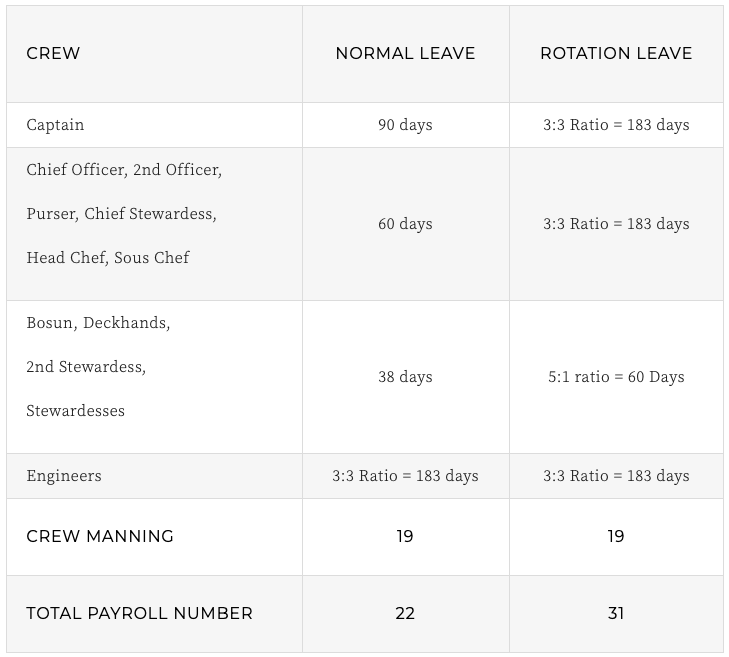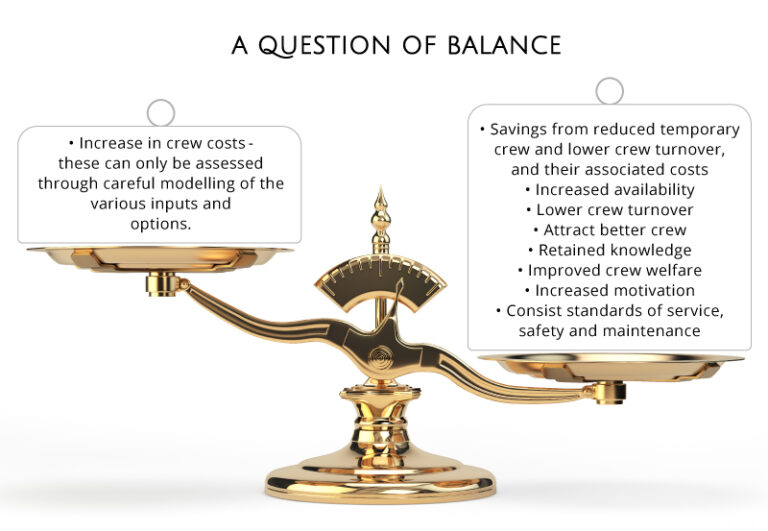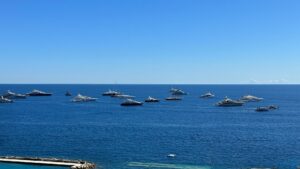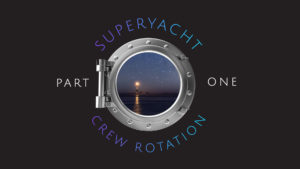Following our last post and feedback, we take a deeper look at rotation. We believe the benefits for crew are well understood, so in this piece we focus mainly on how rotation can improve yacht ownership and whether the benefits outweigh any additional costs involved?
With traditional leave arrangements, crew normally take their accrued leave at the end of a contract if a seasonal job or, when a yachts program allows e.g. at the end of the season, during a refit or crossing, or the off-season lay-up period. This approach means crew may work for prolonged periods before a break and, planning for their leave and/or training required for career progression, is very difficult.
Although a yacht can be admired for its aesthetic beauty and technical excellence, ultimately it is the professional crew who are responsible for ensuring the yacht delivers on the dreams and aspirations of an owner. Employing and retaining the very best crew is, without doubt, fundamental to success. And, as the fleet grows and yachts get bigger, the competition for quality crew will only increase; to meet this challenge terms of employment will need to evolve and rotation will become an ever more important consideration for many.
So What is Rotation?
I think the simplest explanation is job-sharing, where, most commonly, two crew share the same job and alternate their time onboard and on leave. This is normally the situation with the most senior crew with work/leave ratios such as 2:2 or 3:3 and other crew on ratios such as 5:1 or 3.1.
Although there may be different variations/ratios, not all crew have to be on the same terms, the general principle is that the yacht is fully manned at all times and leave is properly scheduled – within accepted variances due to a yachts program.
With any job share, especially in positions of leadership and responsibility, one of the challenges is ensuring the two people sharing the job have mutual respect, similar ethics, behaviour and work standards. This dynamic is important as consistency is fundamental to the health of the team. Any major differences can lead to uncertainty and confusion amongst the crew and a breakdown in the team and performance – success, relies on identifying and employing the right crew.
Yacht Availability – Asset Optimisation
Large yachts are a significant investment, and one of the joys of yacht ownership is the freedom to use it without restriction. Therefore, outside of crossings or refit, any time a yacht is unavailable to a yacht owner or, for charter, would seem to be a poor return on the investment.
Even on one season yachts I have seen where the lack of crew has prevented an owner from using their yacht in winter, and there are some stunning days in the winter in the Med! This was frustrating for the owner and something that did not make sense given the investment involved, including the capital costs and operational expenditure.
Rotation ensures that it is the yacht owner who determines when to use the yacht and is not restricted due to crew leave, or quality diminished by use of temporary crew. Lack of crew due to leave commitments would no longer be a reason to curtail use or compromise on safe manning in port.
Temporary Crew
Temporary crew is an option for replacing crew on leave and keeping the yacht available to the owner, though this is not normally the most successful strategy as recruitment is often at short notice and choice may be limited.
Further, there is no guarantee they will perform, have the same professional standards, gel with the crew and/or yacht owner and family. The training and supervision they will require and, repeated every time a temp is used, is a drain on crew resources creating inefficiencies in the team’s performance and the yachts operation. This can have a negative impact on the quality of service, levels of safety, standards of maintenance and the yacht owner’s experience.
Employing temporary crew has repeating costs such as agency fees, salary, uniform and travel and these can be used to offset the additional cost of permanent crew required for rotation.
Crew Retention
It is widely accepted that long periods onboard without a suitable break can lead to fatigue and burnout, especially on busy yachts, and the uncertainty in leave planning and difficulty in having a normal life off the yacht can affect the welfare and well-being of crew. All these are contributing factors to the high turnover of crew that is so often complained about in our industry.
The senior crew are even more exposed to these stresses due to the pressures of their roles. These are the mature/older more experienced crew that others look to for leadership, training and motivation – they are the foundation on which the long-term success of the yacht is built. Many will have reached a point their career and/or life where they may have a family or, in a relationship, and are interested in building a fulfilling life away from the yacht.
Junior crew tend to have different priorities, as alluded to in Part I, so whilst extended leave is not so important, a reasonable amount of leave and having the ability to plan for their time off is still a key influence.
Rotation also provides opportunities for advancement and helps remove another oft cited reason for leaving. For example, it may allow a chief officer to step up to rotational captain, or a 2nd stewardess to become rotational chief stewardess. It adds to motivation and further helps retain the skills and knowledge built-up through mentoring and their time served onboard.
Although yacht owners may be frustrated by the constant churn of crew, they may not fully appreciate the hard and soft costs involved. The hard costs include such things as recruitment fees, employment setup costs, uniform, training, etc. and easiest to explain. The soft costs, although harder to put a monetary value on, are also important considerations. Arguably, the biggest cost to crew turnover is the loss of knowledge which could be technical, operational or, even personal to the yacht owner and family. There is also the disruption to the team and operation, and the time and effort required to train and supervise new crew on their journey to becoming an integral part of the team. And, all of these could affect a yacht owners enjoyment; something you cannot put a value on!
It’s also difficult to appreciate the importance a yacht owner places on seeing familiar faces amongst the crew; it helps them relax, and gives them comfort in the knowledge that the crew understand their needs and will make their stay flow seamlessly. I have heard familiarity being used as a reason against rotation due to the additional crew, but this should not be a major concern as it doesn’t take long for those crew to be a familiar sight – they just won’t all be onboard at the same time!
Rotation does not completely eliminate crew turnover as there will always be influences outside the control of the yacht but, by incentivising crew through better leave and improved employment prospects, a yacht owner can remove some of the key reasons for leaving.
Yes, But Rotation Is Expensive!
This is often, understandingly, the refrain from yacht owners and rightly so, as the payroll can be between 25% – 40% of the operating budget, and it is frequently the captain who must explain how increasing these costs can be of benefit a yacht owner.
Within any proposal, the crew must also buy-in to the idea and understand that a trade-off may be required on their part. It would seem obvious to anyone that if you work less then you should be paid less? Unfortunately, crew do not always see it this way and some expect to work significantly less days whilst still earning the same money – this stance is often where the idea never even gets off the ground. That being said, there are examples of very generous salaries combined with rotation – there is no standard in yachting!
Once an owner recognises the benefits it is clearly easier to implement prior to employment of the crew, such as during a new-build or before purchase. Changing an operational yacht to a rotational structure is a little more challenging due to the uplift in costs, and any salary negotiations that may be required.
The examples below show how changing annual leave allowances affects the number of days worked per year.
- 90 days leave per year, plus one day off per week when onboard, effectively works 236 days per year. On 1:1 rotation they work 183 days per year (no day off per week). This is a reduction of 22%.
- 60 days leave per year, plus one day off per week when onboard, effectively works 261 days per year. On 1:1 rotation they work 183 days per year (no day off per week). This is a reduction of 30%.
- 38 days leave per year, plus one day off per week when onboard, effectively works 280 days per year. On 5:1 rotation, plus one day off per week when onboard, they work 261 days per year. This is a reduction of 7%.
An interesting point is that a full-time employee in the UK with statutory holiday, public holidays and weekends, effectively works 228 days per year.
The effective workdays is also the number used to calculate the daily pay rate. Using that figure you can see that to keep the rate the same would result in a salary reduction by the same percentage – as mentioned, this is something that crew may find difficult to accept, but may also make the salary uncompetitive.
As an exercise I developed a detailed spreadsheet that compares a ‘normal’ yacht with a crew complement of 19 onboard with average salaries, leave and travel costs, against the same yacht with a ‘rotation’ – the table below summarises the leave differences.
The junior crew are on a 5:1 rotation which, in general, may suit them better given their different priorities to the senior crew. There is still a good amount of time off to rest and recuperate and, importantly, an ability to plan their leave.
What this detailed examination highligthed is that rotation does not result in a doubling crew costs which, is often the assumption. In this particular case the increase in crew costs is between 8% – 24% depending whether salaries are adjusted for effective workdays, left at the original rates, or negotiated somewhere in-between.
Summary
It is clear that there are costs and benefits associated with rotation; although it is important to perform a detailed analysis of all the cost inputs, outputs and variances – this is a fundamental part of any justification. The benefits, apart from the financial savings that can be made through the reduction in temporary crew and crew turnover, are dependent on the value and importance ‘weighting factor’ that an yacht owner places on these, and whether, on balance, these outweigh the costs and add value to the quality of the ownership experience.
Finally, and worth considering; although rotation is not yet the norm, it is growing trend, especially for the larger yachts – although I have heard of its use on <500gt yachts as well – and more crew will be looking for this in the future – I think most yacht crew would agree that this is a positive change and demonstrates the industries progressive growth and evolving maturity.
As we have mentioned previously, OnlyCaptains are not offering prescriptive solutions, we simply present ideas and suggestions that may offer captains some useful ideas that they can use in their own command and act as a catalyst to further industry discussion – we hope you enjoyed this post and welcome any feedback.

